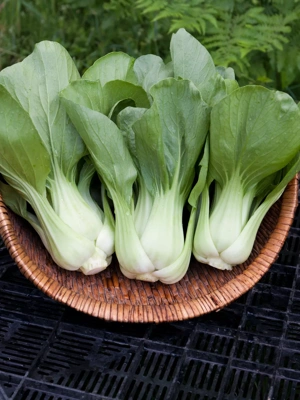Bok Choy

Bok choy, also called Chinese cabbage, and its very similar relative pac choi, sometimes called celery cabbage, are Chinese vegetables that resemble white-stemmed Swiss chard. In Chinese the names mean "white vegetable" even though the leaves are green and it's only the stems and veins that are white. Varieties vary considerably in leaf size and shape, but all are mild-tasting greens that are used widely in Chinese recipes.
Bok choy is a cool-weather crop that will quickly bolt (go to seed) in hot weather. Oddly, it will also bolt if the weather gets too cold (below 50 degrees) when it is young. For this reason it's best to start bok choy indoors about a month before the last frost, and then transplant it outdoors after the soil temperature reaches 50 degrees. Some new varieties are less prone to bolting and will tolerate both heat and cold quite well. To avoid transplant shock, plant seeds in individual cells or soil blocks. Thin to one seedling per pot by using scissors to snip off competing seedlings at the soil level.
Bok choy is a heavy feeder. It needs rich soil with plenty of nitrogen, phosphorus and potassium. Be sure to add plenty of compost and some organic fertilizer to the soil at planting time. It grows best in full sun, but can tolerate some shade. In hot climates, afternoon shade is good because it will delay bolting. If some of the plants do begin to flower, the flowers are tasty in salads. Don't let the plants set seed as they'll spread themselves through your garden and plants will be popping up everywhere for years to come.
Flea beetles love bok choy and will pepper the leaves with little holes. The easiest prevention is to cover the plants with garden fabric (row covers) to keep the beetles from reaching the leaves.
Once the head has firmed up, it's best to harvest bok choy in its entirety. Pac choi can be harvested leaf by leaf, taking the outside leaves and allowing the center of the plant to grow more leaves. If you harvest the entire plant at once, cut it off with a sharp knife and leave the roots in the ground. Give it some liquid fertilizer and it will produce another plant.
Last updated: 01/28/2021
Print this Article:
Related items
Get the Dirt
Stay up to date on new articles and advice. Please fill out the information below.

